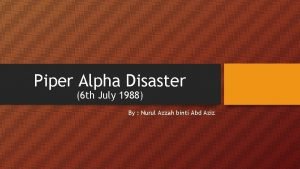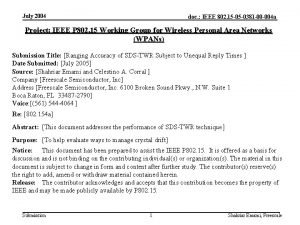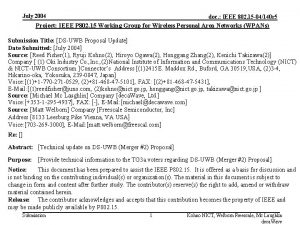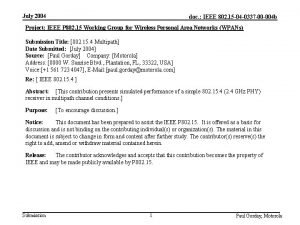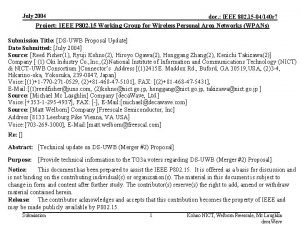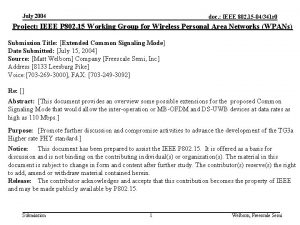July 2004 doc IEEE 802 15 04 r












- Slides: 12

July 2004 doc. : IEEE 802. 15 -04/? ? ? -r 0 Project: IEEE P 802. 15 Working Group for Wireless Personal Area Networks (WPANs) Submission Title: [Bi-Directional CTA] Date Submitted: [July 14, 2004] Source: [Mark E. Schrader] Company [Appairent Technologies Inc. ] Address [150 Lucius Gordon Dr. , Suite 211, West Henrietta, NY 14586] Voice: [+01 -585 -214 -0584], FAX: [+01 -585 -214 -2461], E-Mail: [schrader@appairent. com] Re: [] Abstract: [CTA with round robin access and source device provided time slot proprotions for a pair of devices in an IEEE 802. 15. 3 b WPAN] Purpose: [For discussion to support Bi-directional CTA for IEEE 802. 15. 3 b WPAN] Notice: This document has been prepared to assist the IEEE P 802. 15. It is offered as a basis for discussion and is not binding on the contributing individual(s) or organization(s). The material in this document is subject to change in form and content after further study. The contributor(s) reserve(s) the right to add, amend or withdraw material contained herein. Release: The contributor acknowledges and accepts that this contribution becomes the property of IEEE and may be made publicly available by P 802. 15. Submission 1 Mark E. Schrader, Appairent Technologies Inc.

July 2004 doc. : IEEE 802. 15 -04/? ? ? -r 0 Bi-directional CTA July 2004 Submission 2 Mark E. Schrader, Appairent Technologies Inc.

July 2004 doc. : IEEE 802. 15 -04/? ? ? -r 0 Overview • We propose extending the use of current CTAs to support bi-directionality using the Hall proposal as the foundation and making several additions. • The resultant scheme has the following properties: – First transmit opportunity by Src DEV – Second transmit opportunity by Dest DEV – Alternating opportunities by source and destination DEVs for the duration of the CTA. – Src Dev specified size for each Src DEV time slot and each Dest DEV time slot within the CTA. Submission 3 Mark E. Schrader, Appairent Technologies Inc.

July 2004 doc. : IEEE 802. 15 -04/? ? ? -r 0 Design Criteria 1. Different application spaces will require different restrictions of the fraction of a CTA that the Src DEV and Dest DEV are allowed to consume per access. 2. Only one of the two devices may have data to send during the CTA, or part of the CTA. This should be supported to provide channel utilization, latency, and throughput. 3. A DEV may not have data ready to transmit during in a specific “access window” within the CTA, and may have data ready for transmission later in the CTA. Access opportunities should be maximized to allow devices to transmit when they are ready. 4. A master-slave relationship between the Src DEV and Dest DEV is not appropriate for all application spaces. Submission 4 Mark E. Schrader, Appairent Technologies Inc.

July 2004 doc. : IEEE 802. 15 -04/? ? ? -r 0 Reversal Methods • If a DEV is transmitting: Explicit reversal using reversal bit in the last frame of data • If a DEV is Not transmitting, there are two alternative methods: – Implicit reversal based on no transmission and CCA if a device does not transmit during its access window (TAW) time. – Explicit Reversal-bit-only transmission to reverse control for every access opportunity in the CTA. This is essentially passing the token back and forth. Submission 5 Mark E. Schrader, Appairent Technologies Inc.

July 2004 doc. : IEEE 802. 15 -04/? ? ? -r 0 Proposed Frame Format Additions • 7. 5. 6. 1 Channel time request command format: add 1 octet to specify the maximum fraction of the allocated channel time that can be used per access by the Dest DEV, the value N such that the fraction is N / 256. • Call this 1 octet field the destination time fraction (DTF). • The PNC repeats this value in the response command (section 7. 5. 6. 2) and in the CTA status IE in the beacon (section 7. 10. 4) through the addition of the DTF field in each of those frame formats. • A DTF value of ‘ 0’ means “Unidirectional time slot”. Submission 6 Mark E. Schrader, Appairent Technologies Inc.

July 2004 doc. : IEEE 802. 15 -04/? ? ? -r 0 Time Fractions • The addition of the DTF field does not change the function of the PNC in allocating channel time. • The DTF field is used to tell the Dest DEV the maximum channel time that it may use for transmitting data each time that it is allowed to transmit in the CTA. • The source time fraction is: STF = 1 – DTF, the maximum channel time that the Src DEV may use for each of its allowed transmissions in the CTA. • (A DEV must still keep track when the CTA will end. ) Submission 7 Mark E. Schrader, Appairent Technologies Inc.

July 2004 doc. : IEEE 802. 15 -04/? ? ? -r 0 Definitions for Scenario Slides • TSTF = The amount of time in the CTA usable by the Src DEV • TDTF = The amount of time in the CTA usable by the Dest DEV • TCTA = The total amount of time in the CTA assigned to the Src DEV by the PNC Submission 8 Mark E. Schrader, Appairent Technologies Inc.

July 2004 doc. : IEEE 802. 15 -04/? ? ? -r 0 STF and DTF Scenarios Submission 9 Mark E. Schrader, Appairent Technologies Inc.

July 2004 Submission doc. : IEEE 802. 15 -04/? ? ? -r 0 10 Mark E. Schrader, Appairent Technologies Inc.

July 2004 Submission doc. : IEEE 802. 15 -04/? ? ? -r 0 11 Mark E. Schrader, Appairent Technologies Inc.

July 2004 doc. : IEEE 802. 15 -04/? ? ? -r 0 Summary of Advantages • Controlled source and destination time slot fractions manage access for various applications. Can be equal access to very unequal access • High channel utilization • Maximum number of transmit opportunities per CTA • Src DEV still has priority to transmit in the CTA Submission 12 Mark E. Schrader, Appairent Technologies Inc.











